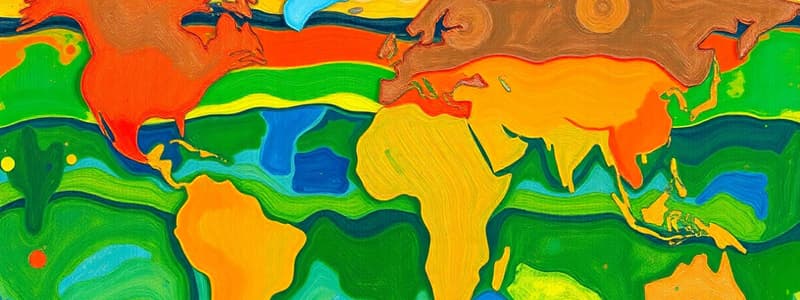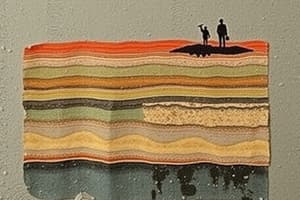Podcast
Questions and Answers
How does the Earth's structure resemble an onion?
How does the Earth's structure resemble an onion?
- Both contain a core that provides energy.
- Both have concentric layers with distinct properties. (correct)
- Both have a hard, protective outer layer.
- Both are formed through similar geological processes.
Which statement accurately compares oceanic and continental crust?
Which statement accurately compares oceanic and continental crust?
- Oceanic crust is primarily composed of granite, while continental crust is basalt.
- Oceanic crust is thinner and denser than continental crust. (correct)
- Continental crust is primarily basalt while oceanic crust is composed of granite.
- Oceanic crust is thicker and less dense than continental crust.
What is the primary role of convection currents within the Earth's mantle?
What is the primary role of convection currents within the Earth's mantle?
- Maintaining the solid state of the mantle.
- Driving the movement of tectonic plates. (correct)
- Regulating the Earth's temperature.
- Generating Earth's magnetic field.
The Earth's magnetic field is generated by what?
The Earth's magnetic field is generated by what?
Despite the high temperatures, what keeps the Earth's inner core in a solid state?
Despite the high temperatures, what keeps the Earth's inner core in a solid state?
Which of Earth's layers is composed of silicate rocks rich in iron and magnesium?
Which of Earth's layers is composed of silicate rocks rich in iron and magnesium?
Which elements are most abundant in the Earth’s crust?
Which elements are most abundant in the Earth’s crust?
How do scientists primarily study the Earth's internal structure?
How do scientists primarily study the Earth's internal structure?
What is the approximate radius of the Earth?
What is the approximate radius of the Earth?
The distribution of which elements primarily shapes the properties of Earth's layers?
The distribution of which elements primarily shapes the properties of Earth's layers?
If a scientist detects seismic waves bending as they pass through a certain layer of the Earth, what does this indicate about the layer?
If a scientist detects seismic waves bending as they pass through a certain layer of the Earth, what does this indicate about the layer?
How would an increase in the density of the Earth's outer core likely affect the planet?
How would an increase in the density of the Earth's outer core likely affect the planet?
What is the average density of Earth?
What is the average density of Earth?
Which layer of the Earth has a direct influence on Earth's spin?
Which layer of the Earth has a direct influence on Earth's spin?
Which of the Earth's layers is liquid?
Which of the Earth's layers is liquid?
Flashcards
Crust
Crust
Earth's outermost solid layer, varying in thickness and composition.
Mantle
Mantle
A thick, mostly solid layer beneath the crust, capable of slow flow.
Outer Core
Outer Core
The liquid layer of iron and nickel generates Earth's magnetic field.
Inner Core
Inner Core
Signup and view all the flashcards
Oceanic Crust
Oceanic Crust
Signup and view all the flashcards
Earth's Crust
Earth's Crust
Signup and view all the flashcards
Mantle Composition
Mantle Composition
Signup and view all the flashcards
Mantle Convection
Mantle Convection
Signup and view all the flashcards
Earth's Composition
Earth's Composition
Signup and view all the flashcards
Seismic Waves
Seismic Waves
Signup and view all the flashcards
Study Notes
- Earth's layers hold secrets that scientists use different methods to explore
Introduction to Earth's Layers
- Earth consists of distinct layers
- Each layer has a different composition and physical properties
- Understanding Earth's layers aids in grasping its dynamics
Overview of Earth's Layers
- The layers include, from outermost to innermost: crust, mantle, outer core, and inner core
- The crust is the outermost solid layer of the Earth
- The mantle is a thick, mostly solid layer
- The outer core is a liquid layer made up of iron and nickel
- The inner core is a solid, dense sphere
Earth's Crust
- Earth's crust is the outermost layer
- It is thin and rigid
- Oceanic and continental crust differ in thickness and composition
- Oceanic crust is thinner, denser, and primarily made of basalt
- Continental crust is thicker, less dense, and made of granite
Earth's Mantle
- The mantle is a thick layer beneath the crust
- It is mostly solid but can flow slowly over time
- Convection currents in the mantle drive plate tectonics
- The mantle is composed of silicate rocks rich in iron and magnesium
- Heat transfer drives plate movement
- The mantle is solid but can flow slowly
Outer Core
- The outer core is a liquid layer of iron and nickel
- Its movement generates Earth's magnetic field, which protects the planet from harmful solar radiation
Inner Core
- The inner core is a solid, dense sphere of iron and nickel
- Extreme pressure keeps the inner core solid, despite high temperatures
- It influences Earth's rotation and magnetic field
- The inner core is made mostly of iron
- Extreme pressure keeps it solid
- The inner core affects Earth's spin
Earth's Composition at a Glance
- Earth's composition varies by layer
- Key elements are iron, oxygen, silicon, and magnesium
- The distribution of elements shapes the Earth's properties
- Crust's major elements - oxygen, silicon, aluminum
- Mantle's major elements - silicon, oxygen, magnesium, and iron
- Outer core's major elements- iron and nickel
- Inner core's major elements - iron and nickel
How We Study Earth's Structure
- Scientists use seismic waves to probe Earth's interior
- Seismic waves are generated by earthquakes and bend/reflect as they travel through different layers
- Analysis of seismic waves reveals layer properties
Conclusion
- Earth's structure is complex and fascinating and plays a vital role
- There are 4 layers: crust, mantle, outer core, inner core
- Approximate Earth radius is 5100 km
- Average density is 5.5 grams per cubic centimeter
Studying That Suits You
Use AI to generate personalized quizzes and flashcards to suit your learning preferences.




